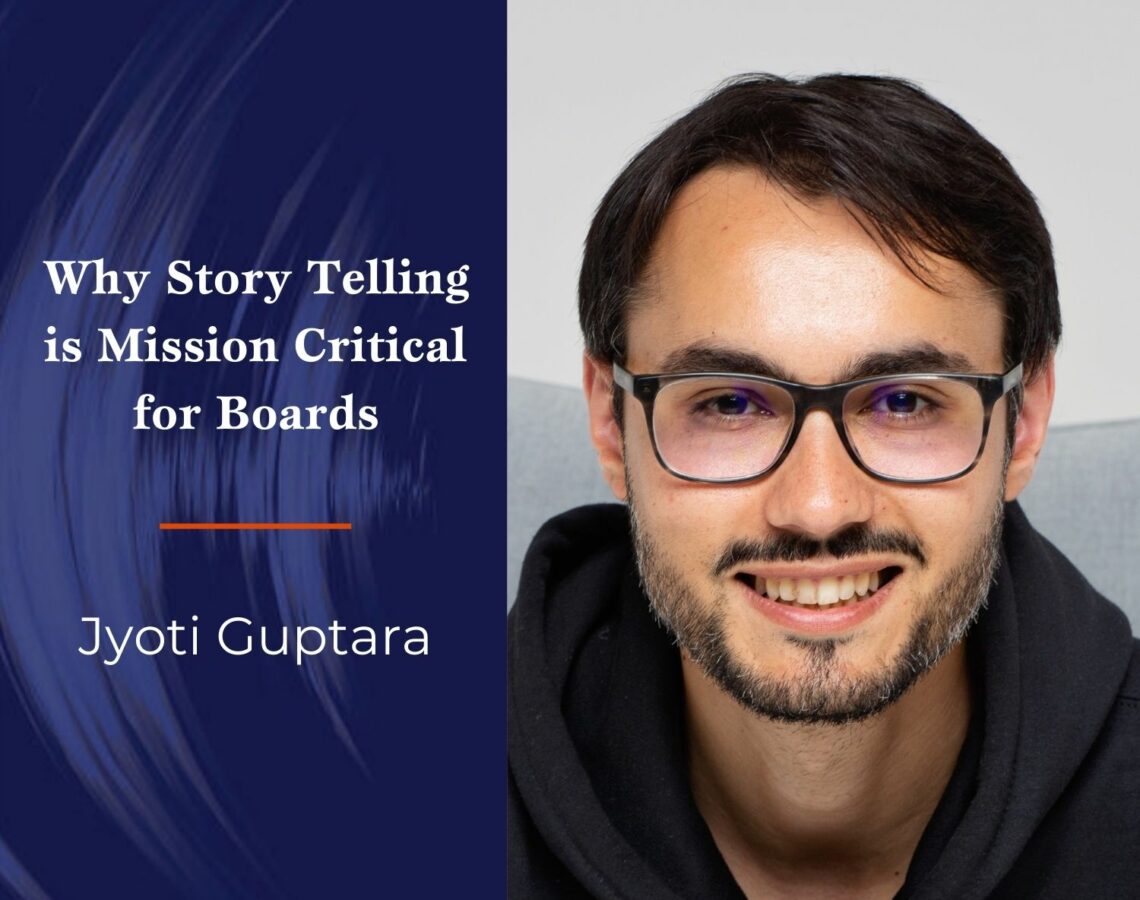Why Story Telling is Mission Critical for Boards

A crucial yet often overlooked aspect of board effectiveness: stories.
A crucial yet often overlooked aspect of board effectiveness: stories. Imagine a world where numbers and strategies come alive, painting a vivid picture of your company’s future. When it comes to decision-making and leadership, how can compelling narratives inspire your board and drive tangible results? The ancient art of storytelling can be your modern tool for boardroom success!
In this podcast, Dr Sabine Dembkowski, Founder and Managing Partner of Better Boards, discusses the importance of stories with Jyoti Guptara, who excels in helping leaders align narratives with corporate culture, fostering an environment where stories become a driving force for organizational identity and strategic direction.
Jyoti is a bestselling author, international speaker, and business storytelling expert. As a consultant, he helps leaders to scale their influence by crafting stories that resonate with different stakeholders. He has worked with start-ups, SMEs, and Fortune 500s, and is a regular contributor to executive education and MBA courses around the world. His book, Business Storytelling from Hype to Hack, has been praised by the CEO of Walmart and by the President of the Institute for Management Development (IMD). His slogan is: “Telling stories is the quickest, cheapest, and deepest way to more influence.”
Some of the key takeaways of the conversation include:
“We really want to tell a story that can connect people, tell them what we’re all about, and invite people to join us on that journey”
Why do many mission statements fail to change behaviour? Why do most change efforts fail? Jyoti says that when these strategic communications are abstract, they don’t connect with people. An important lesson for businesses and leaders is to tell a good story that helps transform abstract ideas, strategies, and mission statements into something graspable and tangible. The brain is an experience simulator. A story can turn mere information into vicarious experience.
Seasonally, if you look at the Christmas story, there’s a message of hope and a personification of the concept of redemption. People can connect with that in a meaningful and memorable way, so the story of Christmas has endured for thousands of years, even among those who don’t practice the faith. Boards can learn from that framework, and Jyoti says this is a huge area of opportunity for them.
“The larger the organisation gets, the more important the story becomes”
Jyoti says companies are struggling to convince people why they should care. This is true even at companies that have a fantastic mission and story. They are struggling to tell a compelling story, and this directly links to the issues that many firms are facing with employee engagement and community building. Storytelling helps create clarity around the mission and work of the company. It also creates the space for community connection and for building a powerful community around a shared mission and values. This is important for every firm, from the smallest to the largest. Still, it is especially critical in larger firms, where the story becomes the glue that holds everything together and helps ensure the long-term survival of the organisation.
“There are different stories for different contexts”
To Jyoti, telling a good story comes down to telling the right story to the right people at the right time in the right way. This requires narrative intelligence, a skill that can be learned and honed with practice. Unfortunately, most MBA programs aren’t teaching this. Many people also have a misperception that stories need to be a certain length or format. They’re thinking of what would work in a film or book, which is not right for board or business settings.
Instead, Jyoti recommends thinking about where you’re telling a story and why: your goal with the story. Different contexts require different stories. He says one basic principle he’s found helpful is to think about story sizes. Some situations have space for a five or 10-minute-sized story. In other situations, you’ve only got 60 seconds. So it would help if you thought about how to fit your message into a smaller package, and even practice telling a key story in short, long, and extended versions.
When working with clients, Jyoti coaches them on ten essential story types. He helps them work on using different structures and finding spaces in daily conversations and interactions to practice simple storytelling. These have the power to shape behaviour on-the-job, versus a beautifully written statement that is not actually referred to.
One good starting point is what he calls a “bridge story,” which is a story that helps establish common ground and build a connection between two people or among group members. After all, once you’ve established that initial connection or trust point, the other party will be primed to listen to you and give you their attention.
“Boards that do get storytelling right can be a lot more effective”
To Jyoti, it’s dangerous for boards to overlook storytelling. Board effectiveness improves when storytelling is in play, and good stories can also help with board development and governance issues.
On an individual level, having a good story can influence who is brought onto the board and who stays on the board. So, to Jyoti, people need to develop strong personal narratives that showcase their experience and expertise. Once a part of a board, the individual stories can help unite the group and build cohesion as everyone gets to know and appreciate each other. This is especially important in board situations where you are trying to bring together a group with diverse backgrounds and perspectives and meld that group into an effective unit.
As a board, storytelling is vital because it is the board’s responsibility to oversee the company’s direction, purpose, vision, and strategy. Jyoti points out that these things are often highly complex and abstract. Storytelling from the board can help give flesh to the bones and turn what would otherwise be something very vague and nebulous into something that people can connect with and understand. Boards need stories to define and articulate their purpose and vision effectively. Then, they’ll want to work closely with the executive team to roll that message out in a way that employees and stakeholders can understand and embrace and then implement when it comes to strategy.
“If people can’t see the vision, it really isn’t a vision. It’s just fancy words.”
Jyoti feels companies who can’t articulate their vision in an effective story have fancy words with no resonance. You need a strong story to succeed! For anyone looking for examples of companies doing great work with stories, he recommends looking at Coca-Cola, Microsoft, and Kempinski hotels. Coca-Cola has invested a lot in using nostalgic stories to sell, while Microsoft has an annual conference for its internal storytellers to ensure their message gets out in the right way. With Kempinski, the firm has done a great job bringing in employees to tell stories and building that into the management culture. By looking at these and other story-based organisations, you can see how to use narrative and story in your own firm and with your own board to drive success and spread your message.
The three top takeaways from our conversation are:
- People are not rational. Our default mode is to be emotional and rationalise after the fact. Remember this, and try to appeal to the whole brain by using stories.
- When people hit you with fact statements or statistics, ask them to reframe it as an anecdote to give a fuller picture of the situation.
- Practice telling stories every day. This will help you hone that tool in low-stakes situations so that you can shine in high-stakes environments.
Don’t forget to subscribe never to miss an episode of the Better Boards Podcast Series. Available on Apple, Spotify or Google.
To find out how you can participate in the Better Boards Podcast Series or more information on Better Boards’ solutions, please email us at info@better-boards.com.



